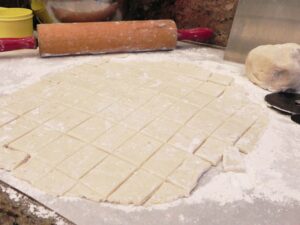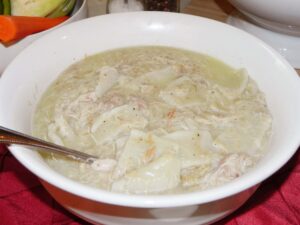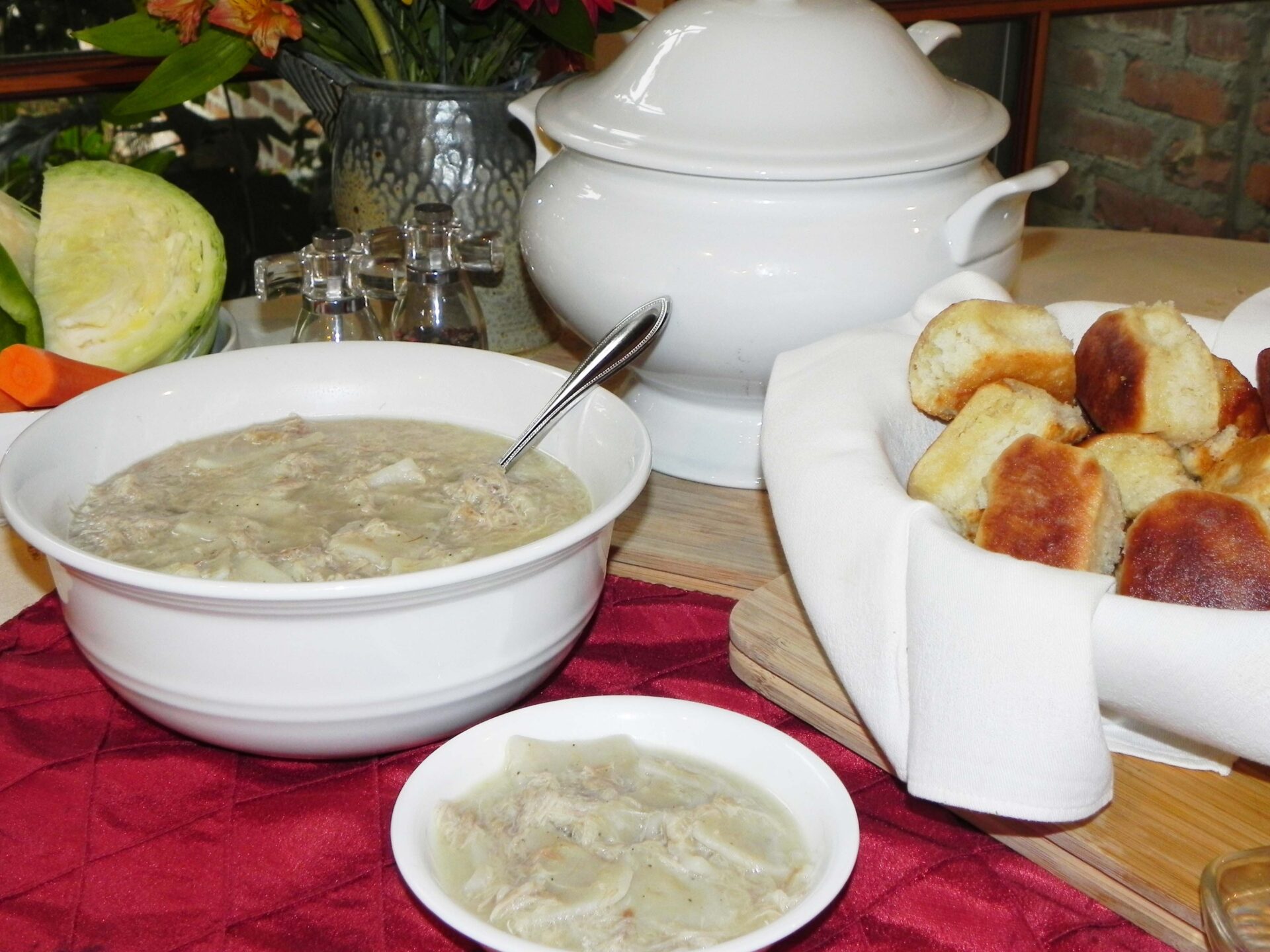Southernism of the Week:
Fat, dumb and happy: What we become in a tryptophan stupor after consuming a hefty Thanksgiving meal and turkey leftovers. A nice state of being during which we forget our sorrows and recent failures …for a while.
CHICKEN AND DUMPLINGS — BACK TO NO-NONSENSE BASICS
Thanksgiving is over. The food budget is depleted. The fancy desserts have been demolished, and the leftovers have dwindled to slim pickings.
It’s time to get back into the kitchen, and rustle up some healthful comfort foods within a budget as we prepare for the next holiday.
This is when my family falls back on the humble dish of chicken and dumplings. The dumpling dinner originated in ancient times as a method for extending meager meat rations to feed hungry workers. A single chicken could be extended for up to three meals in this way, by boiling the chicken to create a savory broth and combining the broth with dumplings and the bits of chicken meat.
The ancient Roman equivalent of our modern Southern dumplings evolved into the gnocchi. The Chinese equivalent evolved into the wonton and pot sticker. The Jewish version evolved into the matzo ball. The English and their Continental counterparts developed their own styles of dumplings and became connoisseurs of variation – some dumplings were filled with fruits or meats, and some plain.
Thick, thin, or biscuit-style, the dumplings for our chicken and dumplings dish are made up as a biscuit dough consisting of flour, shortening (or lard or butter) and water, milk, buttermilk, or chicken stock. The dumplings may be formed into balls, dropped by the tablespoon, or rolled out flat and cut into strips. The dumplings for chicken and dumplings in other parts of the U.S. tend to be the fluffy kind, and those dishes often contain the carrots and celery that we Southerners remove after cooking the chicken.
It is up to the cook to determine whether the consistency of the dish will be thin like a soup, thick like a stew, or even thicker like a casserole. Like the dumplings, this preference has regional overtones.
Our Southern, stew-like version contains flat, noodle-like dumplings. It is thought to have migrated down the settlement trails from the Back Country of Pennsylvania. This working-class dish sustained all Southerners during the dark days after the Civil War.
Although regularly featured at family meals through the 20th century, the dish has fallen out of favor with younger cooks concerned with carbohydrates, calories, time constraints, and fear of tackling the dumplings.
What a pity.
Chicken and dumplings are not nearly as difficult to make as most novice cooks think. They may be made ahead and frozen, and the homemade version is infinitely more tasty and healthful than the canned or frozen versions. It contains no additives, and can be made with gluten-free or whole wheat flour. And above all, the dish is cost effective for feeding a family.
With an eye to thrift when preparing this week’s chicken and dumplings, I purchased a 10-pound bag of chicken leg-thigh quarters. The cost was under $7.
I simmered the entire bag’s contents in a large stock pot filled with water and seasonings, then strained the broth and picked out the cooked meat. The yield was more than 3 pounds of tasty light and dark meat, perfect for making up a large pot of the old-fashioned, all-in-one chicken dish.
CHICKEN AND DUMPLINGS
 This dumpling dough is like icebox rolls – it needs refrigeration for at least 8 hours to become elastic. I like to make up the dough early in the morning for use that night. It also keeps well in the fridge for up to 3 or 4 days. The rolled and cut dumplings can be frozen on a baking tray and then bagged for future use.
This dumpling dough is like icebox rolls – it needs refrigeration for at least 8 hours to become elastic. I like to make up the dough early in the morning for use that night. It also keeps well in the fridge for up to 3 or 4 days. The rolled and cut dumplings can be frozen on a baking tray and then bagged for future use.
Prep the dumplings:
Plain flour, as much as feels right (3-4 c in a dough bowl)
Salt and black pepper to taste
A tiny bit of shortening, about 1 T for 3-4 c of flour
Boiling water, added a little bit at a time
Cut shortening into the seasoned flour with a pastry blender. Add boiling water to the middle and begin working the flour into a dough. The boiling water will make it too hot to do more than caress and fold the flour with fingertips at first. Add more boiling water until the dough becomes sticky. As it cools, work it to completely blend the flour. Roll on a floured surface until the dough is well blended and a bit stiff.
Divide and roll into two balls. Place the two balls in a large non-reactive bowl. Press waxed paper or parchment against the dough balls and cover the bowl with either waxed paper or plastic wrap secured with a rubber band. Allow the dough to cool before using plastic wrap, or the dough will become too wet and gummy in the bowl as it cools.
Refrigerate overnight or at least 8 hours. I have kept dumpling dough in the fridge in this manner as long as four days.
Prep the chicken:
10 lb chicken leg-thigh quarters
2-3 tsp ground thyme
1 T garlic powder
6 cloves garlic, crushed but whole
1 tsp salt
1/2 tsp black pepper
2 ribs of celery
1 large carrot
Rinse and clean any debris from the chicken. Leave skin on. Place chicken, veggies, and seasonings in a large stockpot. Fill with water to 2 inches below the rim. Bring to a boil on medium-high heat. After 10 minutes, lower heat to medium and cover with a splashguard (not a lid). Simmer for an hour, until chicken is falling apart.
Allow pot to cool until warm. Strain the chicken stock through a sieve. Pick out chicken meat from remains and refrigerate the meat and stock separately until ready to use. A layer of chicken fat will form on top of the stock during refrigeration and will be easy to remove. Some cooks reserve the chicken fat in the freezer for ongoing use in place of shortening or lard (The chicken fat is perfect for making up matzo balls).
Make the chicken and dumplings:
 About an hour before serving the meal, heat the chicken stock (fat removed) in a large, well-seasoned stockpot. Add more chicken broth — most of a 48-ounce carton of chicken broth — to fill stockpot to four inches below the rim.
About an hour before serving the meal, heat the chicken stock (fat removed) in a large, well-seasoned stockpot. Add more chicken broth — most of a 48-ounce carton of chicken broth — to fill stockpot to four inches below the rim.
Remove dough from fridge and lightly flour a flat surface lined with parchment paper.
Dough should be very supple. Place it on the floured surface and gently roll to coat with the flour. Flatten and stretch the dough into a rectangular shape. Sprinkle with a bit of flour if needed. Roll the dough out to approximately 1/4-inch thick. The goal is to roll the dumplings very thin like noodles because they will puff up when cooking. Use a pizza cutter to cut the rolled dough into strips about 1-1/2 wide by 2 or 3 inches long.
Stir the boiling chicken stock. Drop dough strips, one at a time, into boiling broth, allowing liquid to resume a full boil between drops if the rolling boil diminishes. Simmer covered for about 30 minutes, making sure to stir gently at intervals to prevent sticking to bottom of pot. Do not skimp on the length of time needed to cook the dumplings. Dumplings are done when no longer transparent and when a test shows the same coloration all the way through (like testing pasta).
Heat the chicken in a small amount of chicken broth in a separate pot. Add the heated chicken and broth to the dumplings stockpot and cover. Simmer 10-20 minutes, stirring to prevent sticking and clumping. Season the dish with additional salt and pepper to taste.
VARIATION: If using frozen store-bought dumplings such as Anne’s or Mary B’s, be sure to allow broth to reach a boil between drops. Cover, and simmer much longer than stated in the package directions.
SHORTCUT DUMPLINGS
This version of dumplings substitutes butter for shortening, and doesn’t require refrigeration. I find that these will scorch more easily than the version made with water.
2 c all-purpose flour
3/4 tsp baking powder
Pinch of salt
2 T salted butter
3/4 c skim or 2% milk
Additional flour for rolling the dumplings
Combine dry ingredients in a large bowl and whisk to blend. Add the butter and cut it into the flour mixture with pastry blender until mixture is crumbly.
Add milk, a bit at a time, working it into the flour with the pastry blender. As the dough comes together, scrape all bits off the pastry blender.
Transfer the dough onto a floured surface, sprinkle with additional flour, and proceed to roll out and cut into strips as noted in the old-fashioned recipe above. These cut dumplings work better if allowed to sit for about a half hour before dropping them into the boiling broth.
Laurie Triplette is a writer, historian, and accredited appraiser of fine arts, dedicated to preserving Southern culture and foodways. Author of the award-winning community family cookbook GIMME SOME SUGAR, DARLIN’, and editor of ZEBRA TALES (Tailgating Recipes from the Ladies of the NFLRA), Triplette is a member of the Association of Food Journalists (AFJ),Southern Foodways Alliance (SFA) and the Southern Food and Beverage Museum (SOFAB). Check out the GIMME SOME SUGAR, DARLIN’ web site and follow Laurie’s food adventures on Facebook and Twitter (@LaurieTriplette).


